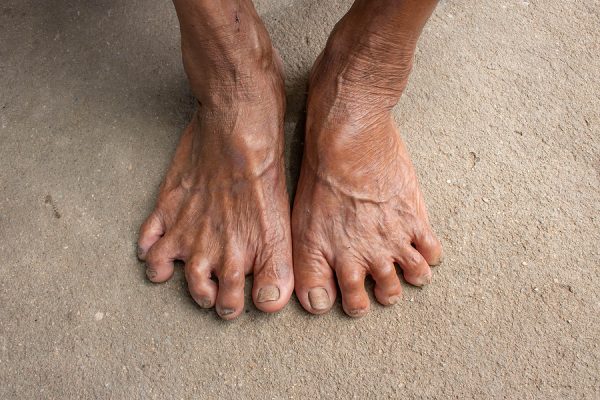By David Blyweiss, M.D., Advanced Natural Wellness
One of the most neglected parts of the human body is the feet.
Most people – especially men, but women can be just as guilty – hide their feet inside a pair of shoes all day when they are out of the house, then tuck them into slippers or socks when they get home.
When they finally get around to looking at their feet, they might discover a bunch of gunk has built up between their toes. And this is truly a mystery – if you’ve had your feet covered all day, where did all this disgusting crap come from?
In non-medical terms, we call this “toe jam.” It’s a combination of dead skin, sock lint, dirt, skin oil, fungi and bacteria.
Toe jam is more likely to develop when you wear socks that hold moisture and shoes that can’t breathe, especially in hot weather. It’s unpleasant. It may or may not stink. But is it a problem?
For most people, the answer is no. But for diabetics, especially those who experience peripheral neuropathy, then yes, it can be a problem.
Toe jam is a breeding ground for bacteria and fungi. Enclosing your feet in socks and shoes only adds fuel to the fire. It creates the perfect dark and moist atmosphere that the fungus associated with athlete’s foot (tinea pedis) needs to thrive.
In the general population this is a minor annoyance.
But in diabetic neuropathy patients, if the tinea causes any cracks or breaks in the skin between the toes, it can become a real health threat. Bacteria can get into these openings and lead to a severe infection.
If the infection gets into the deeper layers of the skin, it can result in cellulitis, which can spread through your body and become life-threatening. Foot ulcers, gangrene, bone infection and amputation are all possible outcomes.
The problem here is that first, poor glycemic control increases the chances of developing athlete’s foot. Second, reduced blood supply in neuropathy means infections escalate faster and heal slower. And third, patients with diabetic neuropathy often have a loss of sensation in their feet. The feet become numb, so they can’t feel pain.
In other words, someone with diabetic neuropathy can get a serious infection in one or both of their feet without even realizing it!
Other Diabetic Foot Risks
Toe jam and athlete’s foot aren’t the only foot worries among patients with peripheral neuropathy.
Something as simple as an ingrown toenail can be risky. If the toenail pinches and pierces the skin, it can result in a bacterial or fungal infection. If the patient tries to trim the nail away with scissors or clippers, it can compound the problem.
Corns and calluses that most people take care of with a file or pumice stone require a different type of care among those with neuropathy. The reason is simple. If a neuropathy patient breaks their skin with one of these tools – which are not sterile in the first place – it once again leaves the foot open to infection.
Cracked heels and diabetes often go hand-in-hand. Without proper care, those cracks can become deep fissures that bleed and become agonizingly painful. These bleeding fissures can lead to the same kinds of infection risks.
And then there is toenail fungus. It can make your nails thick and distorted, which can be very painful and make walking a difficult task. Toenail fungus is one of the most significant predictors in the development of a foot ulcer.
How to Care for Your Feet. Drop the diabetic
The best thing you can do for your feet is to take good care of them, diabetic or not.
- Wash your feet each day, including the area between the toes. Dry gently and thoroughly.
- After washing, inspect your feet and between your toes for any cuts, damage or suspicious areas.
- Use a thick moisturizer or lubricating oil on your feet after cleaning, but DO NOT use it between the toes.
- Choose to wear breathable shoes and moisture-wicking socks.
- If you have peripheral neuropathy, avoid going barefoot at all times.
- Trim your toenails regularly, straight across, with clean nail clippers. File down any sharp edges.
- Do not attempt to remove corns, calluses or ingrown toenails at home. Instead, find a trained foot specialist to deal with these types of issues. They can also help properly treat athlete’s foot and toenail fungus.
- Make sure a qualified healthcare provider examines your feet regularly.
Your feet are a wonderful thing. Take good care of them and they’ll continue to carry you wherever you want to go, whenever you want to go.
SOURCES:
Akkus G, Evran M, Gungor D, Karakas M, Sert M, Tetiker T. Tinea pedis and onychomycosis frequency in diabetes mellitus patients and diabetic foot ulcers. A cross sectional – observational study. Pak J Med Sci. 2016;32(4):891-895.
Eastman DM, Dreyer MA. Neuropathic Ulcer. 2022. In: StatPearls [Internet]. Treasure Island (FL): StatPearls Publishing.
Mayser P, Freund V, Budihardja D. Toenail onychomycosis in diabetic patients: issues and management. Am J Clin Dermatol. 2009;10(4):211-20.
Mishra SC, Chhatbar KC, Kashikar A, Mehndiratta A. Diabetic foot. BMJ. 2017 Nov 16;359:j5064.




